|
On 1st November 1791 the Edinburgh Evening Courant reported the
occasion of the laying of the foundation stone of the new Bridewell
for Edinburgh. There was some ceremonial associated with the event.
With the band of the 53rd Regiment providing a musical accompaniment,
a procession made its way from the Assembly rooms to the site on
Calton Hill. A strict order of precedence applied to the marchers,
headed by the Lord Provost, Magistrates and Council, in their
ceremonial robes, preceded by the sword and mace and followed by the
Sheriff-depute, attended by the Noblemen and Gentlemen of the County.
Bringing up the rear (typically for the time for this kind of
ceremony associated with a new building) were the Masonic Lodges. The
Masonic Grand Master performed the "mysteries" of the
ceremony of laying the foundation stone and gave a short speech in
which he described the building's purpose as a "House of Public
Discipline" required because of "...a degree of corruption
of the manners of the people, to which, I am sorry to add, the too
general use of spirits among the lower classes of both sexes."
The building was intended to be "a terror to the idle and
profligate" who are to "leave it for amendment in their
behaviour and inured to habits of industry".
This description is an interesting vignette of Scotland's hierarical
and authoritarian political establishment of the time. The public
statement of the function the Bridewell was to serve ties in with the
Act of Parliament authorising its construction, passed some ten years
before and with earlier designs for the building dating from that
time. This description does not seem to tie in with the high security
prison that had actually been designed by Robert Adam, that the
foundation stone was being laid for.
[Add Image and description of Brown's designs and the front page
of the 1782 Act ?]
All of Robert Adam's Castle Style designs for the Bridewell in
Edinburgh include a walkway around the outside of the main prison
walls. The detailed design of this walkway varies between the plans
for the different schemes but all include a railed or pallisaded wall
around the outer perimeter. At the angles on each version of the
plans there is a different arrangement proposed to provide a
defensible point, sometimes doubling as a sentry box. The requirement
for defence of the building is explicitly mentioned on one of the
later plans. This is a version where the design has undergone much
paring down (probably to cut costs) but where the walkway is still
included. Around the walkway on this drawing is inscribed a note
"A walk with Wooden Pallisades with Centinel Boxes on the
Angles for guarding the outsides of the Walls, to prevent attacks
from without or getting over the walls from Within"
Presumably it was envisaged that such attacks might be attempted to
try to release the kinds of prisoners who may be kept there.
In addition to this defensive function, the building was designed
with a high level of security internally for those held there. Adam
adopted Jeremy Bentham's Panopticon "invisible inspection"
system for the design of the building. This method of centralised
observation of prisoners, discussed elsewhere, provides a level of
security that seems far in excess of what would be required to hold
the thieves, drunks, prostitutes and vagrants that the building was
ostensibly intended for.
It seems unlikely that the Adam would be adding this kind of
functionality without being asked to do so. To make some guess at
why, it is perhaps necessary to look at the political situation in
Scotland at this time.
Scottish Politics in the late Eighteenth Century - The Rights of Man
In the second half of the eighteenth century Scotland has been
described as a "society that was fundamentally stable but
obsessed with its own instability" [Scotland. A New
History" Michael Lynch]
This view is augmented by a near contemporary view of Henry Thomas
Cockburn (1779-1854) who in his diaries wrote of the Tory party
during the period of the French Revolution in Scotland
"The party engrossed almost the whole wealth, and rank, and
public office, of the country, and at least three fourths of the
population. They could have afforded therefore, to be just and well
tempered. But this as it appears to them would have endangered their
supremacy, which they were aware was upheld by their opponents being
believed to entertain alarming principals and ends. Hence the Tory
object was to abuse everybody but themselves, and in particular to
ascribe a thirst for bloodshed and anarchy, not merely to their
avowed public opponents, but to the whole body of the people. It is
frightful even to recollect the ferocious bitterness and systematic
zeal with which this principal was acted upon; and this under the
direct sanction of Government." [Fyfe, J.G. Scottish
Diaries and Memoirs 1746 -1843. Quoting from Henry Thomas Cockburn]
A Country of Deep Inequalities
Scotland was at this time a country of deep inequalities, but in
which there was a growing clamour for change. However the grip of the
landed interests was tightening. Great landowners owned more than
half the land and were tightening their control over the electoral
system, because the right to vote depended on who held the
superiority of the land as well as those who owned it.
Commercialisation of the landed estates was the passport to wealth
and (London) society . It was the basis of the development of many
great houses of the time such as Culzean.
The great landowners were increasingly remote from their fellow
Scots, both on their own estates and in society as a whole, but they
cocooned their political position using an elaborate apparatus that
depended on wealth, privilege, patronage and a weighted legal system.
This was never so candidly revealed as by the Justice clerk Lord
Braxfield who at the trial of Thomas Muir in 1793 declared that "A
Government in every country should be just like a Corporation, and
in this country, it is made up of landed interests which alone has a
right to be represented." (This
same Judge once famously told a prisoner - "you'll be no
worse of a hangin").
Henry Dundas.
Dubbed at the time "Satrap of Scotland" and "Harry the
ninth, uncrowned king of Scotland", Henry Dundas became a
supreme manipulator of this corrupt political system. Son of a minor
landowner, but also connected to the Edinburgh Legal establishment,
he was a loyal agent of the landed interests as a whole, and of the
Hanovarian monarchy. He sat as MP and became Lord Advocate in 1775,
and managed to dominate the government of Scotland for the next 25 years.
During the American war of Independence he did much to curry favour
with George III, by making exaggerated objections to the Seceeders
anxious to conciliate the American Colonies. George III found his
boot licking egregious and described him in 1778 as a pest, however
the ascendancy of Dundas in Scotland dates from this time. He was
able to stay in control of the Scottish Lobby of MPs and to always
ensure that they voted in a way that suited the crown. In the
Westminster parliament in 1780, at a time when George III was
particularly unpopular, a motion was passed that "the
influence of the Crown has increased, is increasing, and ought to be diminished".
This was passed by 233 to 215 votes, but only 7 of the 45 Scots MP's
had supported it.
Dundas was able to control the vote of the Scots MP's and provide
dependable support and to increase his influence for the next two
decades. In the election of 1780 there were 41 government supporters
returned out of 45 seats, and Dundas personally controlled 12 of
these MP's. By 1784 this number had risen to 22, and in 1786 he
controlled all but one of the Scottish seats.
He would have been helped in this by the very few number of people
eligible to vote in Scotland at the time. In 1788, the thirty
Scottish county members in the post-Union Westminster parliament were
elected by a mere 2,662 votes.
Edinburgh, the only burgh to be individually represented by an MP had
only 33 voters. The system was totally open to
corruption. Henry Dundas himself stated the "it would be easier
to reform Hell". An example was the way the parchment barons
were created at this time, to swamp, where needed, opposition of
"real" voters. On
top of this every other effort was made to secure political
interest. Appointments to British State and Empire and Armed forces
were also managed in the interests of the ruling classes. Reforms
that were being demanded in England did not happen in Scotland at
this time.
Dundas did do some good in Scotland. He liked to practise "civic
virtue". For example he found the finance to complete the
Forth/Clyde canal in1784 and sponsored a number of parliamentary acts
to enable the continuing improvement of Edinburgh, including the
building of the University, now called the Old College.
Challenges to the System
The
political situation in Scotland by 1791 was very delicate. There were
undercurrents of political unrest, and the whole country was poised
for a period of political agitation. That civil unrest was in the air
must have been clear to the authorities.
The American War of Independence, though lost by the British, had
seen many Scots support, fight and indeed die overseas for the
British cause. It had proved to the hilt the loyalty of the Scottish
establishment and Scotland as a nation. There was a degree of
instability throughout Britain caused by the return of soldiers from
the war, many of whom were unable to find employment and turned to
begging and stealing to stave off starvation. This indeed was one of
the causes for an urgent demand for prison reform at that time. With
the loss of the American colonies there was now nowhere to send
"criminals", at least not until the first penal colonies
were established in Botany Bay Australia ten years later.
The political administration of every country in Europe had been
shaken by the phenomena of the French Revolution. How to prevent
heads on pikes would have been in the minds of many at that time. The
French revolution did much to stimulate political awareness in
Scotland, and to awaken people to the possibility of reform, if not
to the methods by which it was being achieved in France, which were
generally deplored, certainly by the middle and upper classes.
In 1792 the most serious challenge to the established order to date
took place. It was provoked by the refusal of the House of Commons in
April 1792 even to set up a committee to investigate the manifold
corruption of the electoral system in the burghs. Effigies of Dundas
were burned in Dundee, Brechin and Aberdeen, and in Edinburgh the
King's birthday was followed by 3 nights of rioting, on 4-6 June.
There was also a growth in the numbers of newspapers. In 1782 there
had been 8 Scottish newspapers. By 1790 there were 27. By 1792 new
newspapers were springing up weekly, the atmosphere being heightened
by the remarkable successes of the French Revolutionary armies in the
summer of 1792. In May the government issued a proclamation against
seditious literature, in an effort to stop the circulation of
handbills and placards. In particular they wanted to prevent the
circulation of the second part of Thomas Payne's Right of Man which
had appeared three months earlier. The proclamation had the reverse
effect, giving the agitation new force, and leading to increased
sales of the book.
Hand in hand with new publications was a burgeoning of political
clubs, which took as their model the Edinburgh Society of the
Friends of the People, formed in late July. Similar organisations
were established in Glasgow, Dundee, Perth and Aberdeen. Dundee
and Perth indeed became radical strongholds. By the
end of 1792 almost every town in South of Aberdeen had it own
parliamentary reform society, as did many villages. Trees of Liberty,
symbols of radical democracy, were planted not only in major towns,
such as Perth, but in more remote and unlikely places, such as
Auchtermuchty and Fochabers.
The membership of these new political organisations was initially
from the Middle classes- merchants, lawyers and shopkeepers.
The first General Convention of the Friends of the People in Scotland
was held later the same year 1792, in Edinburgh. Thomas Muir, a
middle class, educated son of a wealthy Glasgow merchant and himself
an Edinburgh Advocate, read an address that he had received from a
similar Irish body, The Society of United Irishmen. The program was
annual parliaments, universal male suffrage and an end to the war
with France. This
had nothing to do with demands for Scottish Independence; it was a
demand for end to corruption and the right to vote.
The authorities or "possessing classes" were generally
alarmed that a movement that encouraged political mobilisation among
the lower orders might lead on to effective demands for political and
social reform.
What made the response to the French Revolution in Scotland so
alarming to the authorities in Kirk and state was the way in which it
involved groups well below those that were traditionally expected to
take an interest in politics. &ldots;.
The Friends of the People societies after 1792 tended to be led by
merchants, lawyers, manufacturers, teachers, but as the French
Revolution became bloodier &ldots; lower middle class&ldots;. and
skilled craftsmen, moved to the fore.
Money was given by the authorities to writers on papers like the
Edinburgh Herald, and Caledonian Mercury, presumably to encourage
anyone who wanted reform to be branded as a "Leveller",
"Republican", or "French Democrat".
This situation could not be allowed to continue.
--------------------
In Old
Calton Burying Ground, off what is now Waterloo Place, is a memorial
of in the form of an obelisk, a major landmark on the Edinburgh
skyline, that on its plinth has the following inscription.
To the
memory of
THOMAS MUIR
THOMAS
FYSHE PAYNE
WILLIAM SKIRVING
MAURICE MARCAROT
AND
JOSEPH GERRARD
Erected by
THE
FRIENDS OF PARLIAMENTARY REFORM
IN
ENGLAND AND SCOTLAND
1844
The
memorial also records the following:-
"I
have devoted myself to the cause of the People, it is a good cause.
It shall ultimately prevail, it shall finally triumph."
Speech of Thomas Muir at the Court of the Judiciary 30th August 1793
"I
know the what has been done these two days will be re-judged"
Speech of William Skirving at the Court of the Judiciary 7th January 1794
By 1793
all had come to a head. For his speech to the Friends
of the People Convention Thomas Muir was charged with sedition. Found
guilty at his trial in 1794 he was sentenced to 14 years
transportation to Australia. He was followed shortly after by
Fyshe Payne and the others. Only one returned alive.
The Politics of the Bridewell
The stated purpose of the Bridewell was to deal with vagrants, petty
thieves, drunkenness etc. If it was designed to be able to function
as a political prison then this clearly needed to be kept a secret,
given the political atmosphere of the time, if there were not to be
rumbles from the populace that the Bridewell was actually a second
Bastille. The only documentary evidence that might hint at such a
hidden agenda is the description of the purpose of the defensive
perimeter walkway "for guarding the outsides of the Walls, to
prevent attacks from without". Also the high level of
security that the prison was designed to provide (which may just have
been the result of the implementation of the new Panopticon concept,
taken to its logical fulfilment in a built form).
Irrespective of this, that a threat was felt by the authorities, real
or imagined is clear. Given the requirement for a defensive function,
as well as to provide up-to-date facilities for incarceration, the
choice of the Castle Style must have seemed even more appropriate to Adam.
|
Designs for Defensible Positions & Castellated Gates for the
Bridewell Perimeter |
|
Castle Style Scheme 2 |
|
 |
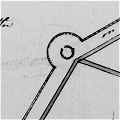 |
 |
 |
|
Fig. 1 Sentry Post and Bastion |
Fig. 2 Sentry Post and Bastion |
Fig. 3 Blockhouse ? |
Fig. 4 Entrance Gate. Note Railing and wall |
|
 |
Fig. 5 Main Entrance Gate - Railings and wall run into
the side of this and into secondary gate (Fig 4). Gates are
fortified and castellated. Sentry Posts have bastions which also have
railings and wall. (Fig 2). |
|
|
|
Castle Style Scheme 3 |
|
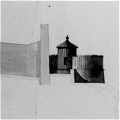 |
Fig. 6 This detail from the East West section, apparently for
CS Scheme 3 actually shows shows the elevation of the perimeter
bastion arrangement of the CS Scheme 2, rather than the arrangements
shown below. A circular sentry box sits within a circular palisade of
sharpened timber stakes, set within a low perimeter wall with railings. |
|
Castle Style Schemes 3 & 4. Figs 7-16 Various
configurations for defensive positions |
|
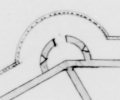 |
 |
 |
 |
|
 |
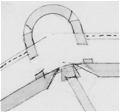 |
 |
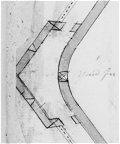 |
|
 |
|
|
 |
-------------------------------------END-------------------------------------- |
|














